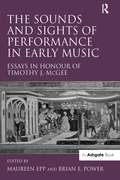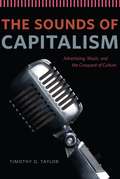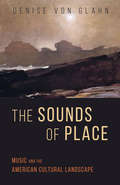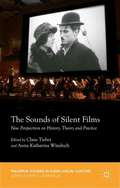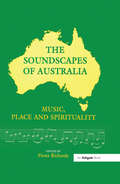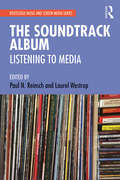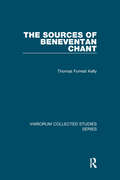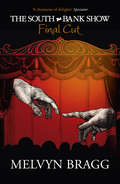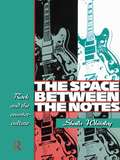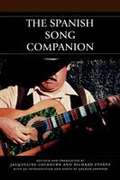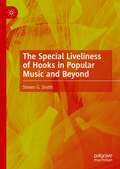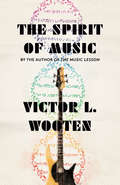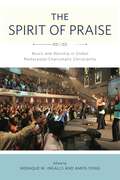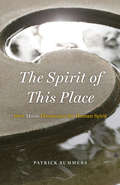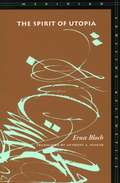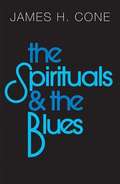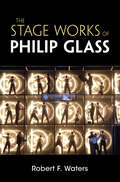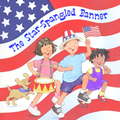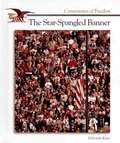- Table View
- List View
The Sounds and Sights of Performance in Early Music: Essays in Honour of Timothy J. McGee
by Maureen Ep Brian E. PowerThe experience of music performance is always far more than the sum of its sounds, and evidence for playing and singing techniques is not only inscribed in music notation but can also be found in many other types of primary source materials. This volume of essays presents a cross-section of new research on performance issues in music of the Middle Ages and Renaissance. The subject is approached from a broad perspective, drawing on areas such as dance history, art history, music iconography and performance traditions from beyond Western Europe. In doing so, the volume continues some of the many lines of inquiry pursued by its dedicatee, Timothy J. McGee, over a lifetime of scholarship devoted to practical questions of playing and singing early music. Expanding the bases of inquiry to include various social, political, historical or aesthetic backgrounds both broadens our knowledge of the issues pertinent to early music performance and informs our understanding of other cultural activities within which music played an important role. The book is divided into two parts: 'Viewing the Evidence' in which visually based information is used to address particular questions of music performance; and 'Reconsidering Contexts' in which diplomatic, commercial and cultural connections to specific repertories or compositions are considered in detail. This book will be of value not only to specialists in early music but to all scholars of the Middle Ages and Renaissance whose interests intersect with the visual, aural and social aspects of music performance.
The Sounds of Capitalism: Advertising, Music, and the Conquest of Culture
by Timothy D. TaylorFrom the early days of radio through the rise of television after World War II to the present, music has been used more and more to sell goods and establish brand identities. And since the 1920s, songs originally written for commercials have become popular songs, and songs written for a popular audience have become irrevocably associated with specific brands and products. Today, musicians move flexibly between the music and advertising worlds, while the line between commercial messages and popular music has become increasingly blurred. Timothy D. Taylor tracks the use of music in American advertising for nearly a century, from variety shows like The Clicquot Club Eskimos to the rise of the jingle, the postwar upsurge in consumerism, and the more complete fusion of popular music and consumption in the 1980s and after. The Sounds of Capitalism is the first book to tell truly the history of music used in advertising in the United States and is an original contribution to this little-studied part of our cultural history.
The Sounds of Paris in Verdi's La traviata
by Emilio Sala Delia CasadeiHow did Paris and its musical landscape influence Verdi's La traviata? In this book, Emilio Sala re-examines La traviata in the cultural context of the French capital in the mid-nineteenth century. Verdi arrived in Paris in 1847 and stayed for almost two years: there, he began his relationship with Giuseppina Strepponi and assiduously attended performances at the popular theatres, whose plays made frequent use of incidental music to intensify emotion and render certain dramatic moments memorable to the audience. It is in one of these popular theatres that Verdi witnessed one of the first performances of Dumas fils' La Dame aux camélias, which became hugely successful in 1852. Making use of primary source material, including unpublished musical works, journal articles and rare documents and images, Sala's close examination of the incidental music of La Dame aux camélias - and its musical context - offers an invaluable interpretation of La traviata's modernity.
The Sounds of Place: Music and the American Cultural Landscape (Music in American Life)
by Denise Von GlahnComposers like Charles Ives, Duke Ellington, Aaron Copland, and Ellen Taaffe Zwilich created works that indelibly commemorated American places. Denise Von Glahn analyzes the soundscapes of fourteen figures whose "place pieces" tell us much about the nation's search for its own voice and about its ever-changing sense of self. She connects each composer's feelings about the United States and their reasons for creating a piece to the music, while analyzing their compositional techniques, tunes, and styles. Approaching the compositions in chronological order, Von Glahn reveals how works that celebrated the wilderness gave way to music engaged with humanity's influence--benign and otherwise--on the landscape, before environmentalism inspired a return to nature themes in the late twentieth century. Wide-ranging and astute, The Sounds of Place explores high art music's role in the making of national myth and memory.
The Sounds of Silent Films
by Claus Tieber Anna K. WindischThe Sounds of Silent Films is a unique collection of investigatory and theoretical essays that, for the first time, unite up-to-date research on the complex historical performance practices of silent film accompaniment with in-depth analyses of relevant case studies.
The Soundscapes of Australia: Music, Place and Spirituality
by Fiona RichardsAustralia offers tremendous scope for understanding the relationship between music, spirituality and landscape. This major, generously-illustrated new volume examines, in fifteen chapters, some of the ways in which composers and performers have attempted to convey a sense of the Australian landscape through musical means. The book embraces the different approaches of ethnomusicology, gender studies, musical analysis, performance studies and cultural history. Ranging across the country, from remote parts of the Northern Territory to the bustling east coast cities, from Tasmanian wilderness to tropical Queensland, the book includes references to art and literature as well as music. Issues of national identity, belonging and aboriginalization are an integral part of the book, with indigenous responses to place examined alongside music from the western orchestral, chamber and choral repertories. The book provides valuable insight into a wide range of music inspired by Australia, from the Yanyuwa people to Jewish communities in Victoria; from Peter Sculthorpe's opera Quiros to the work of European expats living in Australia before the Second World War; from historic Ealing film scores to contemporary sound installations. The work of many significant composers is discussed in detail, among them Ross Edwards, Barry Conyngham, David Lumsdaine, Anne Boyd and Fritz Hart. Throughout the book there is a sense of the vibrancy and diversity of the music inspired by the sights and sounds of the Australian landscape.
The Soundtrack Album: Listening to Media
by Paul Reinsch Laurel WestrupThe Soundtrack Album: Listening to Media offers the first sustained exploration of the soundtrack album as a distinctive form of media. Soundtrack albums have been part of our media and musical landscape for decades, enduring across formats from vinyl and 8-tracks to streaming playlists. This book makes the case that soundtrack albums are more than promotional tools for films, television shows, or video games— they are complex media texts that reward a detailed analysis. The collection’s contributors explore a diverse range of soundtrack albums, from Super Fly to Stranger Things, revealing how these albums change our understanding of the music and film industries and the audio-visual relationships that drive them. An excellent resource for students of Music, Media Studies, and Film/Screen Media courses, The Soundtrack Album offers interdisciplinary perspectives and opens new areas for exploration in music and media studies.
The Sources of Beneventan Chant (Variorum Collected Studies #980)
by Thomas Forrest KellyThe area whose capital was the southern Lombard city of Benevento developed a culture identified with the characteristic form of writing known as the Beneventan script, which was used throughout the area and was brought to perfection at the abbey of Montecassino in the late eleventh century. This repertory, along with other now-vanished or suppressed local varieties of music, give a far richer picture of the variety of musical practice in early medieval Europe than was formerly available. Thomas Forrest Kelly has identified and collected the surviving sources of an important repertory of early medieval music; this is the so-called Beneventan Chant, used in southern Italy in the early middle ages, before the adoption there of the now-universal music known as Gregorian chant. Because it was deliberately suppressed in the course of the eleventh century, this music survives mostly in fragments and palimpsests, and the fascinating process of restoring the repertory piece by piece is told in the studies in this book. A companion volume to this collection also by Professor Kelly details the practice of Medieval music.
The South Bank Show: Final Cut
by Melvyn BraggWhat drives a musician to write extraordinary songs? How do writers create their worlds? How does an actor achieve greatness?For over thirty years of The South Bank Show, Melvyn Bragg has interviewed many of the greatest cultural icons of our age. These interviews offer revelatory insights into the lives and work of writers, actors, artists and musicians. In The South Bank Show: Final Cut he has revisited some of these artists and used the interviews as the basis for fuller portraits.The range of artists is remarkable and this book is true to The South Bank Show?s ethos of seeking out the highest quality whatever the art form.Melvyn Bragg?s unique perspective makes this book indispensable for anyone interested in the work and lives of some of the best artists of our time.
The South Bank Show: Final Cut
by Melvyn BraggWhat drives a musician to write extraordinary songs? How do writers create their worlds? How does an actor achieve greatness?For over thirty years of The South Bank Show, Melvyn Bragg has interviewed many of the greatest cultural icons of our age. These interviews offer revelatory insights into the lives and work of writers, actors, artists and musicians. In The South Bank Show: Final Cut he has revisited some of these artists and used the interviews as the basis for fuller portraits.The range of artists is remarkable and this book is true to The South Bank Show’s ethos of seeking out the highest quality whatever the art form.Melvyn Bragg’s unique perspective makes this book indispensable for anyone interested in the work and lives of some of the best artists of our time.
The Space Between the Notes: Rock and the Counter-Culture
by Sheila WhiteleyThe Space Between the Notes examines a series of relationships central to sixties counter-culture: psychedelic coding and rock music, the Rolling Stones and Charles Manson, the Beatles and the `Summers of love', Jimi Hendrix and hallucinogenics, Pink Floyd and space rock. Sheila Whiteley combines musicology and socio-cultural analysis to illuminate this terrain, illustrating her argument with key recordings of the time: Cream's She Walks Like a Bearded Rainbow, Hendrix's Hey Joe, Pink Floyd's Set the Controls For the Heat of the Sun, The Move's I Can Hear the Grass Grow, among others.The appropriation of progressive rock by young urban dance bands in the 1990s make this study of sixties and seventies counter-culture a timely intervention. It will inform students of popular music and culture, and spark off recognition and interest from those that lived through the period as well as a new generation that draw inspiration from its iconography and sensibilities today.
The Spanish Song Companion
by Richard Stokes Jacqueline CockburnThe Spanish song companion introduces the English-speaking reader to the rich heritage of Spanish songs. Here in one volume are the texts of over 300 songs with parallel translations in accurate and readable English. The majority are love poems, which form a fascinating anthology of Spanish poetry from the thirteenth to the twentieth century. The introduction by Graham Johnson, who in recent years has done more than anyone to kindle interest in the international song repertoire, traces the history of Spanish song from its beginning, via the period of the Catholic kings in the fifteenth century, the Golden Age of the sixteenth, through to the remarkable rebirth in the twentieth century. All the songs and cycles frequently heard in recital are gathered here: Albeniz, Falla, Granados, Rodrigo and Obradors are generously represented, as well as Catalan composers such as Montsalvatge and Mompou. The volume is arranged chronologically by composer, and includes notes on all the major poets and composers, a discography, and names and addresses of the music publishers. Jacqueline Cockburn is Head of History of Art at Westminster School and an associated lecturer at Birkbeck College, University of London. RICHARD STOKES is author of J. S. Bach: The Complete Cantatas (Scarecrow Press, 2004), The Book of Lieder (Faber and Faber, 2005), and co-author of A French Song Companion, with Graham Johnson (Oxford University Press, 2000). Graham Johnson, the founder of the internationally acclaimed Songmakers' Almanac, is an admired accompanist with an unrivaled knowledge of song literature. In this electronic edition, each line of Spanish is followed on the next line by its line in English translation. DAISY markup has chapters at level 1 and each poet and each song at level 2.
The Special Liveliness of Hooks in Popular Music and Beyond
by Steven G. SmithThis book illuminates the aesthetically underrated meaningfulness of particular elements in works of art and aesthetic experiences generally. Beginning from the idea of "hooks" in popular song, the book identifies experiences of special liveliness that are of enduring interest, supporting contemplation and probing discussion. When hooks are placed in the foreground of aesthetic experience, so is an enthusiastic “grabbing back” by the experiencer who forms a quasi-personal bond with the beloved singular moment and is probably inclined to share this still-evolving realization of value with others. This book presents numerous models of enthusiastic “grabbing back” that are art-critically motivated to explain how hooks achieve their effects and philosophically motivated to discover how hooks and hook appreciation contribute to a more ideally desirable life. Framing hook appreciation with a defensible general model of aesthetic experience, this book gives an unprecedented demonstration of the substantial aesthetic and philosophical interest of hook-centered inquiry.
The Spectral Piano
by Marilyn Nonken Hugues DufourtThe most influential compositional movement of the past fifty years, spectralism was informed by digital technology but also extended the aesthetics of pianist-composers such as Franz Liszt, Alexander Scriabin and Claude Debussy. Students of Olivier Messiaen such as Tristan Murail and Gérard Grisey sought to create a cooperative committed to exploring the evolution of timbre in time as a basis for the musical experience. In The Spectral Piano, Marilyn Nonken shows how the spectral attitude was influenced by developments in technology but also continued a tradition of performative and compositional virtuosity. Nonken explores shared fascinations with the musical experience, which united spectralists with their Romantic and early Modern predecessors. Examining Murail's Territoires de l'oubli, Jonathan Harvey's Tombeau de Messiaen, Joshua Fineberg's Veils, and Edmund Campion's A Complete Wealth of Time, she reveals how spectral concerns relate not only to the past but also to contemporary developments in philosophical aesthetics.
The Spirit of Music: The Lesson Continues
by Victor L. WootenGrammy Award winner Victor Wooten's inspiring parable of the importance of music and the threats that it faces in today's world. We may not realize it as we listen to the soundtrack of our lives through tiny earbuds, but music and all that it encompasses is disappearing all around us. In this fable-like story three musicians from around the world are mysteriously summoned to Nashville, the Music City, to join together with Victor to do battle against the "Phasers," whose blinking "music-cancelling" headphones silence and destroy all musical sound. Only by coming together, connecting, and making the joyful sounds of immediate, "live" music can the world be restored to the power and spirit of music.A VINTAGE ORIGINAL
The Spirit of Praise: Music and Worship in Global Pentecostal-Charismatic Christianity
by Amos Yong Monique M. IngallsIn The Spirit of Praise, Monique Ingalls and Amos Yong bring together a multidisciplinary, scholarly exploration of music and worship in global pentecostal-charismatic Christianity at the beginning of the twenty-first century. The Spirit of Praise contends that gaining a full understanding of this influential religious movement requires close listening to its songs and careful attention to its patterns of worship. The essays in this volume place ethnomusicological, theological, historical, and sociological perspectives into dialogue. By engaging with these disciplines and exploring themes of interconnection, interface, and identity within musical and ritual practices, the essays illuminate larger social processes such as globalization, sacralization, and secularization, as well as the role of religion in social and cultural change. Aside from the editors, the contributors are Peter Althouse, Will Boone, Mark Evans, Ryan R. Gladwin, Birgitta J. Johnson, Jean Ngoya Kidula, Miranda Klaver, Andrew Mall, Kimberly Jenkins Marshall, Andrew M. McCoy, Martijn Oosterbaan, Dave Perkins, Wen Reagan, Tanya Riches, Michael Webb, and Michael Wilkinson.
The Spirit of Praise: Music and Worship in Global Pentecostal-Charismatic Christianity
by Amos Yong Monique M. IngallsIn The Spirit of Praise, Monique Ingalls and Amos Yong bring together a multidisciplinary, scholarly exploration of music and worship in global pentecostal-charismatic Christianity at the beginning of the twenty-first century. The Spirit of Praise contends that gaining a full understanding of this influential religious movement requires close listening to its songs and careful attention to its patterns of worship. The essays in this volume place ethnomusicological, theological, historical, and sociological perspectives into dialogue. By engaging with these disciplines and exploring themes of interconnection, interface, and identity within musical and ritual practices, the essays illuminate larger social processes such as globalization, sacralization, and secularization, as well as the role of religion in social and cultural change. Aside from the editors, the contributors are Peter Althouse, Will Boone, Mark Evans, Ryan R. Gladwin, Birgitta J. Johnson, Jean Ngoya Kidula, Miranda Klaver, Andrew Mall, Kimberly Jenkins Marshall, Andrew M. McCoy, Martijn Oosterbaan, Dave Perkins, Wen Reagan, Tanya Riches, Michael Webb, and Michael Wilkinson.
The Spirit of This Place: How Music Illuminates the Human Spirit (The\rice University Campbell Lectures)
by Patrick SummersArtists today are at a crossroads. With funding for the arts and humanities endowments perpetually under attack, and school districts all over the United States scrapping their art curricula altogether, the place of the arts in our civic future is uncertain to say the least. At the same time, faced with the problems of the modern world—from water shortages and grave health concerns to global climate change and the now constant threat of terrorism—one might question the urgency of this waning support for the arts. In the politically fraught world we live in, is the “felt” experience even something worth fighting for? In this soul-searching collection of vignettes, Patrick Summers gives us an adamant, impassioned affirmative. Art, he argues, nurtures freedom of thought, and is more necessary now than ever before. As artistic director of the Houston Grand Opera, Summers is well positioned to take stock of the limitations of the professional arts world—a world where the conversation revolves almost entirely around financial questions and whose reputation tends toward elitism—and to remind us of art’s fundamental relationship to joy and meaning. Offering a vehement defense of long-form arts in a world with a short attention span, Summers argues that art is spiritual, and that music in particular has the ability to ask spiritual questions, to inspire cathartic pathos, and to express spiritual truths. Summers guides us through his personal encounters with art and music in disparate places, from Houston’s Rothko Chapel to a music classroom in rural China, and reflects on musical works he has conducted all over the world. Assessing the growing canon of new operas performed in American opera houses today, he calls for musical artists to be innovative and brave as opera continues to reinvent itself. This book is a moving credo elucidating Summers’s belief that the arts, especially music, help us to understand our own humanity as intellectual, aesthetic, and ultimately spiritual.
The Spirit of Utopia
by Ernst BlochThe Spirit of Utopia is one of the great historic books from the beginning of the century, but it is not an obsolete one. In its style of thinking, a peculiar amalgam of biblical, Marxist, and Expressionist turns, in its analytical skills deeply informed by Simmel, taking its information from both Hegel and Schopenhauer for the groundwork of its metaphysics of music but consistently interpreting the cultural legacy in the light of a certain Marxism.
The Spirituals and the Blues: An Interpretation
by James H. ConeCone explores two classic aspects of African-American culture--the spirituals and the blues. He tells the captivating story of how slaves and the children of slaves used this music to affirm their essential humanity in the face of oppression. The blues are shown to be a "this-worldly" expression of cultural and political rebellion. The spirituals tell about the "attempt to carve out a significant existence in a very trying situation. "
The Spooky Wheels on the Bus
by J. Elizabeth MillsTHE SPOOKY WHEELS ON THE BUS is a humorous Halloween-themed version of the classic song THE WHEELS ON THE BUS. . . with a few ghoulish tricks and treats up its sleeves! Count from One Spooky Bus up to Ten Goofy Ghosts as this Halloween ride races through town picking up a few unsuspecting passengers along the way.
The Sporty One: My Life as a Spice Girl
by Melanie ChisholmAn intimate memoir from international pop star Melanie Chisholm--better known as Mel C. or Sporty Spice--chronicling her trajectory from small-town girl to overnight icon as part of the Spice Girls. 25 years ago, The Spice Girls, a girl band that began after five women answered an ad in the paper, released their first single. 'Wannabe' became a hit and from that moment and, almost overnight, Melanie Chisholm went from small town girl to Sporty Spice, part of one of the biggest music groups in history. Beginning in her bedroom in the north-west of England dreaming of performing on stage, THE SPORTY ONE follows the meteoric rise of the Melanie and The Spice Girls, from the incredible highs of becoming one of the world&’s most recognizable popstars – playing at Wembley, conquering the BRITs, closing the Olympics – to the difficult lows. For the first time ever, Melanie talks about the pressures of fame, the shaming and bullying she experienced, the struggles she has had with her body image and mental health, and the difficulty of finding yourself when the whole world knows your name. THE SPORTY ONE is an incredible story of resilience, hope and how you can find your power.
The Stage Works of Philip Glass (Composers on the Stage)
by Robert F. WatersThe Stage Works of Philip Glass is the first publication to exclusively examine Glass's stage works from 1976 to the present day. Glass, who is regularly acclaimed as the most popular living classical composer, created stage works that have had a mesmerizing effect on younger generations. Robert Waters analyses Glass and his music for the theatre in the context of other composers interested in so-called minimalist features. His discussion includes three introductory chapters that address the validity versus invalidity of terms such as minimalism, post-minimalism, postmodernism, and neo-Romanticism, together with a brief overview of Glass's life and works. Waters examines the different types of theatre responsible for Glass's impact, including Robert Wilson's Theater of Images. He sheds light on Glass's philosophy regarding staging, text, and other theatrical components, which includes a defiance of conventional narrative, visual and aural dissociation as a theatrical technique, and deconstructionist concepts.
The Star Spangled Banner: Conductor Score (Pictureback(R))
by Francis Scott KeyDid you know that the largest sculptures in the world are the presidents' heads on Mount Rushmore? Featuring bright, bold pictures illustrating national pastimes, monuments, and moments in history, this patriotic Pictureback is a great way to introduce kids to our National Anthem. Lyrics to "The Star-Spangled Banner" are on each page, as well as fun and informational sidebars about America.
The Star-Spangled Banner (Cornerstones of Freedom)
by Deborah KentTAn account of how, during the War of 1812, Francis Scott Key came to write the poem that became the national anthem.
